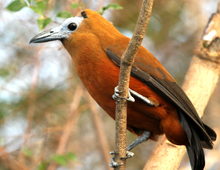Description: Capuchinbirds, also known as Calfbirds (due to the sound of their call) have an unmistakable and odd appearance. Most of the head is featherless, making the head look too small for its body. The skin on the crown and face is a pale bluish gray. The body is mainly cinnamon brown, getting brighter on the lower underparts. Wings are dusky with white underwing coverts. The tail is black.
Size: A fairly large bird, males reach around 14 inches (35.5 cm) in length and 12.7 ounces (360 gr) in weight; females grow to be about 13.5 inches (34.5 cm) long and 11.3 ounces (319 gr) in weight.
Behavior: When not in leks, Capuchinbirds are quite solitary. They can be seen in various levels of the forest, although they are most commonly found in the subcanopy and middle levels. When males lek, as many as eight may gather in understory trees – usually a dominant male and his subordinates. They display by emitting a loud call. Somewhat “synchronized” moo-calls by two males in close proximity to each other are often heard.
Diet: Their diet consists mainly of fruit, but large insects are also consumed.
Communication: The call of the Capuchinbird is very similar to the lowing of a calf, giving them the common name of Calfbird. Inhaled air is stored in sacks on either side of the neck. When the bird is finished breathing in, it will lean back and “moo” with feathers fluffed out around the bare head. The call is loud and carries for long distances.
Reproduction: Nest is a small open cup made out of twigs. It is usually built 10-20 feet (3-6 m) above ground in an understory tree. Clutch size is one egg that is incubated for about 26-27 days. The female incubates the eggs, feeds the chicks and tends the nest.
Habitat/range: It is found in Brazil, Colombia, French Guiana, Guyana, Suriname, and Venezuela. Its natural habitat is subtropical or tropical moist lowland forests.
Status: The Capuchinbird is categorized as Least Concern (LC) on the IUCN Red List.



